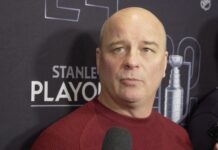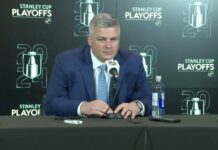After an optional “skills day” practice on Monday, Sheldon Keefe discussed the development plan for Rasmus Sandin without any game action for him as of yet, the status of the team’s injured players, and the decision to start John Tavares and William Nylander over Auston Matthews and Mitch Marner in three-on-three overtime versus Edmonton.
Can you outline what the purpose of today’s workouts was?
Keefe: Looking at it, we just felt that there are different portions of the team that needed different things here today. There is a good chunk of the team that we felt was important to give a second day away from the ice. It is a chance to recover from the 10 games in 18 days that we just played. We’re also coming back from the West and we were getting in really late — it was 4 a.m. when I got to bed getting back from Edmonton. That in and of itself is something to recover from. We wanted to give ample time for that.
There is another group of guys that haven’t played as much, or there are some very specific things that we want them to work at. This was a chance to use today for that. We felt it was productive and we liked what we got out of it.
How important is it to have a guy like Nik Antropov around to help out with a few Russian speakers who might have some communication issues still?
Keefe: It is great, for sure — not just for the language thing, which is the obvious one, but as a member of our development staff here now for a few seasons, he has really picked up and learned a great deal from the skill development standpoint and the things that are important for us from a fundamental skill standpoint. He has gotten to the point where he is running sessions on his own here now. He is a great asset for us to have.
The Matthews line gets a lot of credit for its offense. What do you see as their potential as a three-zone line? Is it harder for them to achieve that because of the offense they carry?
Keefe: I think there is a balance there for sure. They carry a bit of an offensive burden given the abilities they have and what they mean to the team. They know they are relied upon to produce offense. At the same time, we have made it very clear — not to just them but the entire team — that we have to prioritize defense. We have to be better that way. We are looking to generate offense through defending well and frustrating teams and getting pucks back with teams in vulnerable positions where they are not ready to defend. That can be an advantage for us.
It is a bit of an adjustment with that mindset. Those guys are finding their way through it. With everything that we have seen from Matthews and Marner on the defensive side of it with the difficult matchups they have had throughout, it has been really good to see.
What is the key to keeping guys like Rasmus Sandin engaged and preventing him from getting frustrated about not having played in a game yet?
Keefe: We talk to him as much as we can and make sure we are providing some variety on the ice with what he is getting. He is a little bit different than the other members of the “stay ready” group just because he is actually in every one of our practices and is getting the proper reps. We would like to have eight defensemen and run a regular rotation.
For the other extra guys that come into our practices, they are not getting regular reps. He is getting that added benefit. At the same time, we are sensitive to the idea that he hasn’t played yet, and how difficult that is. It is not just for this season — it has, of course, been a long break for him without playing from the initial pause all the way until now.
At the same time, we have really tried to prioritize using this time productively with him to maintain or really improve his work habits and his time in the gym with his training, maturing his body, and learning what is necessary to be an everyday NHL player. That’s not just from a skills standpoint, but the habits that go into it — when you have a year off, everything that you are doing to take care of yourself and improve yourself. There is some growth to be had there.
We have spoken with him about that. Framing it right, he can use his time productively in that manner. We do have no doubts he is going to be an everyday NHL player, but we need him to be prepared as possible for when that happens.
You need patience. He is not the only one who is going through this, whether it is our organization or other organizations around the league. There are a lot of players that want to play and aren’t. He has got to remain patient and take advantage of every day he has with the NHL team. He has a chance to learn skating with NHL players.
We have remained healthy on the backend, which has limited what we have been able to do. We have had Lehtonen ahead of him in terms of getting into the lineup. He has got to continue to stay ready and learn and get better through the process here.
Can you give us an update on the status of the injured players and the progress they’re making?
Keefe: The only update would be that they are making progress. Thornton and Robertson skated today. That is a good sign, but they are still on the same timelines. Nothing has changed there. But it’s very positive to see them on the ice and moving. That is good.
Campbell is progressing as well, but still, nothing has changed there. All I can really say is that there has been progress but the initial timelines still remain.
What is the process that goes into who starts in three-on-three overtime? Is it a feel thing about who is going at the end of regulation? Is it about matchups? What do you consider?
Keefe: I consider a lot of things. We have a plan going through generally that I would start Matthews and Marner. Those would be the two that I would start, and you’ll see that most consistently. The circumstances in the games really dictate things and might change that.
In the case the other night, we saw that Matthews had played two-and-a-half out of the final three minutes of regulation in a bid to make a push to try to win the game in regulation time and not go to overtime. Having gone through that, by the time overtime had started, I looked down the bench and didn’t feel that Auston was quite ready to go out again and skate up and down the rink at three on three. I felt another minute or so would be beneficial to him.
We made the decision to go with John and Will. In overtime, with the circumstances being what they are, I thought John made a tremendous play to spring Will, who had a chance to win the game and it didn’t go in for us. They countered, like usually happens at three-on-three, and it went in for them.
Generally, our plan would be to start Auston and Mitch like we have in previous games, but in the circumstances, you’re always adjusting.


![Sheldon Keefe on the Maple Leafs’ struggling power play: “[We’ve scored] one out of 11 high-danger chances in tight to the net… We have been in those spots and haven’t converted” Sheldon Keefe, playoff press conference](https://mapleleafshotstove.com/wp-content/uploads/2024/04/keefe-pc-game-3-218x150.jpg)

![Jim Montgomery Post Game, Bruins 4 vs. Leafs 2: “[Marchand] still manages to get under people’s skin, yet he doesn’t cross the line” Jim Montgomery, Boston Bruins post game](https://mapleleafshotstove.com/wp-content/uploads/2024/04/jim-monty-pg-to-218x150.jpg)























![Sheldon Keefe on the Maple Leafs’ struggling power play: “[We’ve scored] one out of 11 high-danger chances in tight to the net… We have been in those spots and haven’t converted” Sheldon Keefe, playoff press conference](https://mapleleafshotstove.com/wp-content/uploads/2024/04/keefe-pc-game-3-100x70.jpg)



![Jim Montgomery Post Game, Bruins 4 vs. Leafs 2: “[Marchand] still manages to get under people’s skin, yet he doesn’t cross the line” Jim Montgomery, Boston Bruins post game](https://mapleleafshotstove.com/wp-content/uploads/2024/04/jim-monty-pg-to-100x70.jpg)

